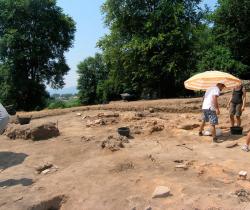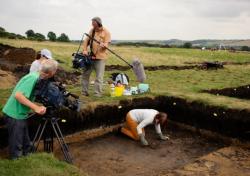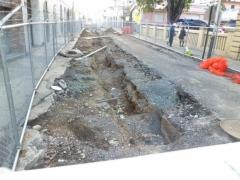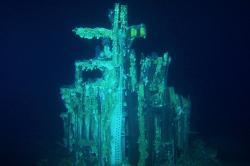INSTITUT SUPERIEUR D'ANTHROPOLOGIE
INSTITUTE OF ANTHROPOLOGY
ONLINE COURSES / COURS A DISTANCE
SPRING SESSION : APRIL 2013
REGISTER NOW
FRANCE –  Laon - Des fouilles ont permis de découvrir des vestiges de la tour David, sur le chantier de l'ancien Monoprix. Elles ont débuté lundi, et dureront normalement 4 à 5 mois. Cela fait partie évidemment des aléas de la construction, notamment dans la cité médiévale. Il y a un an environ (de janvier à mars 2012), un diagnostic d'archéologie préventive a été réalisé au niveau du chantier de l'ancien Monoprix. Un rapport épais et complet a été rendu en juin par l'archéologue de la Ville. En conclusion, il est indiqué que ce travail préliminaire a permis de mettre au jour la base de la tour David, côté rue Franklin-Roosevelt. Il s'agirait de la partie occidentale de la première porte Lupsault, aujourd'hui disparue, et qui se situait en bas de la Caisse d'épargne. Le monument daterait du début du XIIIes et serait le pendant septentrional en quelque sorte de la porte des Chenizelles. Il faut savoir que le terrain concerné correspond à l'emplacement de construction du palais royal et du donjon par Philippe Auguste, en 1212. Pour l'archéologue, il y a matière en tout cas à reprendre des fouilles plus poussées, d'autant qu'il n'existerait plus de plan ou représentation cette porte Lupsault et de ses abords.
Laon - Des fouilles ont permis de découvrir des vestiges de la tour David, sur le chantier de l'ancien Monoprix. Elles ont débuté lundi, et dureront normalement 4 à 5 mois. Cela fait partie évidemment des aléas de la construction, notamment dans la cité médiévale. Il y a un an environ (de janvier à mars 2012), un diagnostic d'archéologie préventive a été réalisé au niveau du chantier de l'ancien Monoprix. Un rapport épais et complet a été rendu en juin par l'archéologue de la Ville. En conclusion, il est indiqué que ce travail préliminaire a permis de mettre au jour la base de la tour David, côté rue Franklin-Roosevelt. Il s'agirait de la partie occidentale de la première porte Lupsault, aujourd'hui disparue, et qui se situait en bas de la Caisse d'épargne. Le monument daterait du début du XIIIes et serait le pendant septentrional en quelque sorte de la porte des Chenizelles. Il faut savoir que le terrain concerné correspond à l'emplacement de construction du palais royal et du donjon par Philippe Auguste, en 1212. Pour l'archéologue, il y a matière en tout cas à reprendre des fouilles plus poussées, d'autant qu'il n'existerait plus de plan ou représentation cette porte Lupsault et de ses abords.
http://www.lunion.presse.fr/article/societe/des-vestiges-mis-a-jour-sur-un-chantier
GRECE –  Dikili Tash - At the prehistoric settlement of Dikili Tash, around 2 klm. East of the ancient city of Philippoi, there is an ongoing archaeological activity since 1961, through a joint Greek-French excavational programme (The Archaeological Society in Athens & The French School of Athens). A new research session started at 2008 under the direction of P. Darque, Ch. Koukouli-Chrysanthaki, D. Malamidou and Z. Tsirtsoni. As reported: “Dikili Tash is one of the best documented sites of the Balkans for the periods from the Early Neolithic (around 6400-6200 BC) up to the Late Bronze Age (12th century BC). The residential remains are plenty and preserved in an unusually good condition. In one of the buildings currently excavated, “House 1”, dating at the 2nd half of the 5th millennium (4400-4200 BC), large quantities of carbonized pressed grapes (vitis vinifera), indicating that fresh grapes had been pressed to produce juice. Several pots, surviving as a whole or in pieces, found near the grapes, contained probably these grapes or their juice. This impressive and unusual find is probably the earliest indication of wine making in Europe. ”Research on defining the way of treating vines (microscopic and chemical analysis) is taking place with the cooperation of Tania Valamoti and is funded by National Geographic Society. More plant species have also been found : rovies (vicia ervilia), wheat (triticum monococcum) and flax (linum usitatissimum), the latter probably used for its oil or its fiber. ”Such seeds as well as the quantities in which they have been found indicate that “House 1”’ s destruction took place in autumn, during a period that the crop had been stored for the following winter”.
Dikili Tash - At the prehistoric settlement of Dikili Tash, around 2 klm. East of the ancient city of Philippoi, there is an ongoing archaeological activity since 1961, through a joint Greek-French excavational programme (The Archaeological Society in Athens & The French School of Athens). A new research session started at 2008 under the direction of P. Darque, Ch. Koukouli-Chrysanthaki, D. Malamidou and Z. Tsirtsoni. As reported: “Dikili Tash is one of the best documented sites of the Balkans for the periods from the Early Neolithic (around 6400-6200 BC) up to the Late Bronze Age (12th century BC). The residential remains are plenty and preserved in an unusually good condition. In one of the buildings currently excavated, “House 1”, dating at the 2nd half of the 5th millennium (4400-4200 BC), large quantities of carbonized pressed grapes (vitis vinifera), indicating that fresh grapes had been pressed to produce juice. Several pots, surviving as a whole or in pieces, found near the grapes, contained probably these grapes or their juice. This impressive and unusual find is probably the earliest indication of wine making in Europe. ”Research on defining the way of treating vines (microscopic and chemical analysis) is taking place with the cooperation of Tania Valamoti and is funded by National Geographic Society. More plant species have also been found : rovies (vicia ervilia), wheat (triticum monococcum) and flax (linum usitatissimum), the latter probably used for its oil or its fiber. ”Such seeds as well as the quantities in which they have been found indicate that “House 1”’ s destruction took place in autumn, during a period that the crop had been stored for the following winter”.
http://www.archaiologia.gr/en/blog/2013/03/21/revealing-a-neolithic-household/
ROYAUME UNI –  Star Carr - An Ancient Monument which is home to the most important archaeological site of its kind in the UK could find itself within 500 metres of a major potato merchant operation. The proposal includes the installation of a new fuel tank, the relocation of a workshop, a new concrete paved area for vehicle washing, new off-street parking, and installation of electronic security gates. If approved the industrial operation will sit directly next the Star Carr Mesolithic archaeological site, which has been dubbed by experts as being as important to the Mesolithic period as Stonehenge is to the Neolithic period. The site has been studied since 1948, it is home to Britain’s earliest surviving house dating back to 9,000 BC. Dr Nicky Milner, an archaeologist from the University York, who has been studying the site, described what has been found there: “What we have here is a massive site, we have structures and we have a timber platform on the edge of what would have been a lake. This suggests that people were living here for quite a long period, for generations, in a large group.”
Star Carr - An Ancient Monument which is home to the most important archaeological site of its kind in the UK could find itself within 500 metres of a major potato merchant operation. The proposal includes the installation of a new fuel tank, the relocation of a workshop, a new concrete paved area for vehicle washing, new off-street parking, and installation of electronic security gates. If approved the industrial operation will sit directly next the Star Carr Mesolithic archaeological site, which has been dubbed by experts as being as important to the Mesolithic period as Stonehenge is to the Neolithic period. The site has been studied since 1948, it is home to Britain’s earliest surviving house dating back to 9,000 BC. Dr Nicky Milner, an archaeologist from the University York, who has been studying the site, described what has been found there: “What we have here is a massive site, we have structures and we have a timber platform on the edge of what would have been a lake. This suggests that people were living here for quite a long period, for generations, in a large group.”
http://www.thescarboroughnews.co.uk/news/environment/industrial-expansion-at-ancient-monument-1-5512223
ROYAUME UNI – Newark - Ground-penetrating radar is to be used to find out whether a subterranean system of caves and tunnels exists beneath Newark Market Place. Anne Coyne, of Farndon Archaeological Research Investigations, said: “Generations of people from Newark have perpetuated the myth of tunnels and passageways running under the town, but there has never been physical evidence of it.” It is said that tunnels were created to protect townsfolk and aid movement of arms and supplies during the three Civil War sieges of Newark. Initial research and radar-plotting of cellars and passageways will be carried out by Trent and Peak Archaeology, who have been doing similar work with the Notting-ham cave system. The project will start on April 2.
http://www.newarkadvertiser.co.uk/articles/news/Tunnel-vision-for-tourism
ILES VIERGES /USA –  St Thomas - The excavation of a major archaeological find discovered in the course of the Rothschild Francis Market Square construction project has been pushed back until after the St. Thomas Carnival, March 31 to April 27. In late January, a 200-foot trench on Krondprindsens Gade between Strand and General gades revealed the presence of a midden, or prehistoric food waste dumping site containing artifacts dating back 1,500 to 2,500 years.
St Thomas - The excavation of a major archaeological find discovered in the course of the Rothschild Francis Market Square construction project has been pushed back until after the St. Thomas Carnival, March 31 to April 27. In late January, a 200-foot trench on Krondprindsens Gade between Strand and General gades revealed the presence of a midden, or prehistoric food waste dumping site containing artifacts dating back 1,500 to 2,500 years.
http://virginislandsdailynews.com/news/carnival-prompts-public-works-to-delay-archaeological-dig-1.1460935?localLinksEnabled=false
USA –  Cape Canaveral —Jeff Bezos, founder of Amazon, assembled a team that has recovered pieces of the powerful Saturn V moon rocket engines from the floor of the Atlantic Ocean, more than 13,000 feet underwater. None of the engines are complete—the impact of hitting the water at a high rate of speed mangled them, and salt water has corroded many of the serial numbers from the components. Bezos’s goal had been to recover the engines from the Apollo 11 flight, but without serial numbers, it will be impossible to identify the specific rocket propelled by the engine parts. The team will try to reassemble one or two complete engines from what is available for museum display. The engines remain the property of NASA. For video of a Remotely Operated Vehicle at work recovering an Apollo F-1 engine, visit the Bezos Expeditions website.
Cape Canaveral —Jeff Bezos, founder of Amazon, assembled a team that has recovered pieces of the powerful Saturn V moon rocket engines from the floor of the Atlantic Ocean, more than 13,000 feet underwater. None of the engines are complete—the impact of hitting the water at a high rate of speed mangled them, and salt water has corroded many of the serial numbers from the components. Bezos’s goal had been to recover the engines from the Apollo 11 flight, but without serial numbers, it will be impossible to identify the specific rocket propelled by the engine parts. The team will try to reassemble one or two complete engines from what is available for museum display. The engines remain the property of NASA. For video of a Remotely Operated Vehicle at work recovering an Apollo F-1 engine, visit the Bezos Expeditions website.
http://www.bezosexpeditions.com/updates.html